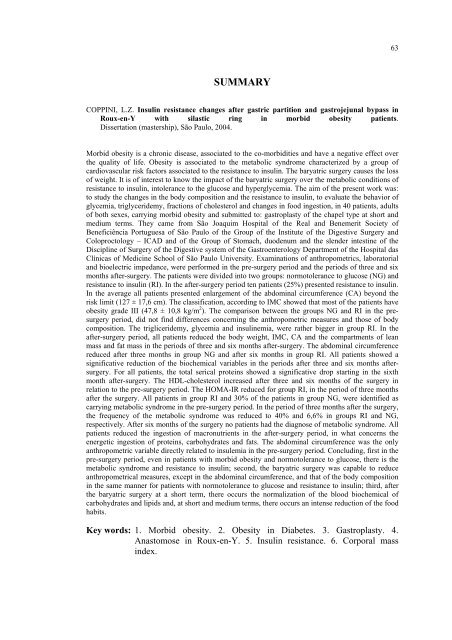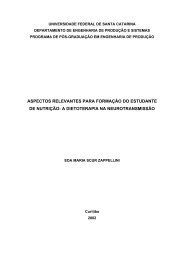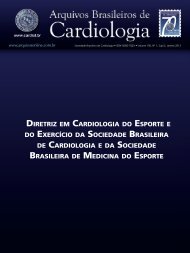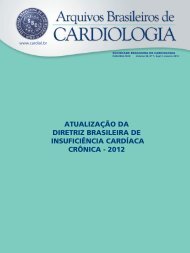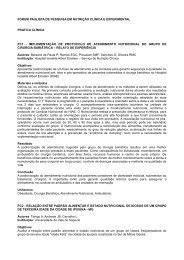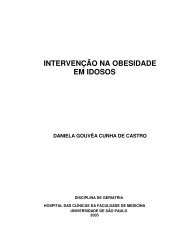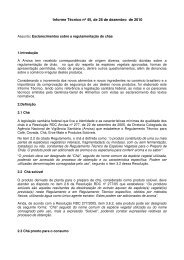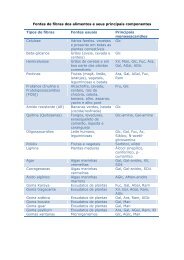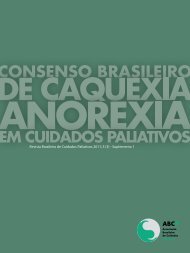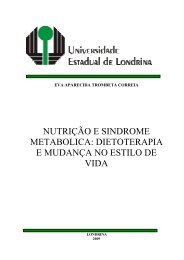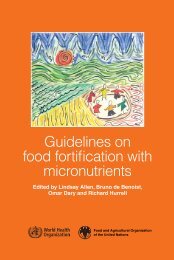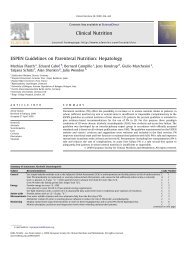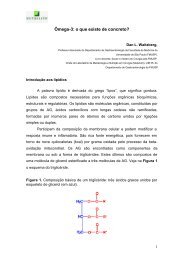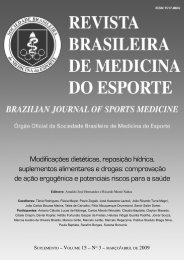Modificações da resistência à insulina após septação ... - Nutritotal
Modificações da resistência à insulina após septação ... - Nutritotal
Modificações da resistência à insulina após septação ... - Nutritotal
- No tags were found...
You also want an ePaper? Increase the reach of your titles
YUMPU automatically turns print PDFs into web optimized ePapers that Google loves.
63SUMMARYCOPPINI, L.Z. Insulin resistance changes after gastric partition and gastrojejunal bypass inRoux-en-Y with silastic ring in morbid obesity patients.Dissertation (mastership), São Paulo, 2004.Morbid obesity is a chronic disease, associated to the co-morbidities and have a negative effect overthe quality of life. Obesity is associated to the metabolic syndrome characterized by a group ofcardiovascular risk factors associated to the resistance to insulin. The baryatric surgery causes the lossof weight. It is of interest to know the impact of the baryatric surgery over the metabolic conditions ofresistance to insulin, intolerance to the glucose and hyperglycemia. The aim of the present work was:to study the changes in the body composition and the resistance to insulin, to evaluate the behavior ofglycemia, triglyceridemy, fractions of cholesterol and changes in food ingestion, in 40 patients, adultsof both sexes, carrying morbid obesity and submitted to: gastroplasty of the chapel type at short andmedium terms. They came from São Joaquim Hospital of the Real and Benemerit Society ofBeneficiência Portuguesa of São Paulo of the Group of the Institute of the Digestive Surgery andColoproctology – ICAD and of the Group of Stomach, duodenum and the slender intestine of theDiscipline of Surgery of the Digestive system of the Gastroenterology Department of the Hospital <strong>da</strong>sClínicas of Medicine School of São Paulo University. Examinations of anthropometrics, laboratorialand bioelectric impe<strong>da</strong>nce, were performed in the pre-surgery period and the periods of three and sixmonths after-surgery. The patients were divided into two groups: normotolerance to glucose (NG) andresistance to insulin (RI). In the after-surgery period ten patients (25%) presented resistance to insulin.In the average all patients presented enlargement of the abdominal circumference (CA) beyond therisk limit (127 ± 17,6 cm). The classification, according to IMC showed that most of the patients haveobesity grade III (47,8 ± 10,8 kg/m 2 ). The comparison between the groups NG and RI in the presurgeryperiod, did not find differences concerning the anthropometric measures and those of bodycomposition. The trigliceridemy, glycemia and insulinemia, were rather bigger in group RI. In theafter-surgery period, all patients reduced the body weight, IMC, CA and the compartments of leanmass and fat mass in the periods of three and six months after-surgery. The abdominal circumferencereduced after three months in group NG and after six months in group RI. All patients showed asignificative reduction of the biochemical variables in the periods after three and six months aftersurgery.For all patients, the total serical proteins showed a significative drop starting in the sixthmonth after-surgery. The HDL-cholesterol increased after three and six months of the surgery inrelation to the pre-surgery period. The HOMA-IR reduced for group RI, in the period of three monthsafter the surgery. All patients in group RI and 30% of the patients in group NG, were identified ascarrying metabolic syndrome in the pre-surgery period. In the period of three months after the surgery,the frequency of the metabolic syndrome was reduced to 40% and 6,6% in groups RI and NG,respectively. After six months of the surgery no patients had the diagnose of metabolic syndrome. Allpatients reduced the ingestion of macronutrients in the after-surgery period, in what concerns theenergetic ingestion of proteins, carbohydrates and fats. The abdominal circumference was the onlyanthropometric variable directly related to insulemia in the pre-surgery period. Concluding, first in thepre-surgery period, even in patients with morbid obesity and normotolerance to glucose, there is themetabolic syndrome and resistance to insulin; second, the baryatric surgery was capable to reduceanthropometrical measures, except in the abdominal circumference, and that of the body compositionin the same manner for patients with normotolerance to glucose and resistance to insulin; third, afterthe baryatric surgery at a short term, there occurs the normalization of the blood biochemical ofcarbohydrates and lipids and, at short and medium terms, there occurs an intense reduction of the foodhabits.Key words: 1. Morbid obesity. 2. Obesity in Diabetes. 3. Gastroplasty. 4.Anastomose in Roux-en-Y. 5. Insulin resistance. 6. Corporal massindex.


